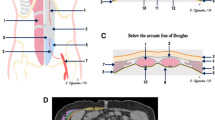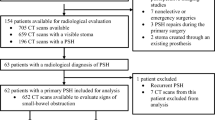Abstract
Purpose
To validate the need of continuing the current practice of histologic examination of hernia sacs (HS).
Methods
All HS received by our laboratory over 15 years were reviewed for any pathological findings. Cases harboring these results were selectively re-examined histologically by a pathologist and their charts were reviewed by a surgeon checking for clinical significance. Moreover, previous studies were analyzed to reach a final conclusion.
Results
Pathological findings were noted in only 13.7 and 12.8 % of adults and kids HS, respectively. None of these had significant impact on patient care.
Conclusions
Serious pathologies reported in HS in the literature are rare. This, coupled with our data, suggest that the current practice of routine microscopic examination of HS is not justified. Criteria are proposed for categorizing cases as eligible for histologic evaluation. This will significantly reduce the workload and contain the cost.


Similar content being viewed by others
References
College of American Pathologists [Internet] (2009) Surgical specimens to be submitted to pathology for examination. http://www.cap.org/apps/docs/laboratory_accreditation/build/pdf/surgical_specimens.pdf
Smoot EC III (1988) Does this go to pathology? Plast Reconstr Surg 81:809
Fitzgibbons P, Cleary K (1996) CAP offers recommendations on selecting surgical specimens for examination. CAP Today 10:40
Netser JC, Robinson RA, Smith RJ et al (1997) Value-based pathology: a cost–benefit analysis of the examination of routine and nonroutine tonsil and adenoid specimens. Am J Clin Pathol 108:158–165
Boutin P, Hogshead H (1992) Surgical pathology of the intervertebral disc: is routine examination necessary? Spine 17:1236–1238
Munoz E, Margolis IB, Wise L (1986) Surgonomics and cost containment. Surg Gynecol Obstet 162:137–141
Cataldo PA, MacKeigan JM (1992) The necessity of routine pathologic evaluation of hemorrhoidectomy specimens. Surg Gynecol Obstet 174:302–304
Matthyssens LE, Ziol M, Barrat C, et al (2006) Routine surgical pathology in general surgery. Br J Surg 93(3):362–368
Siddiqui K1, Nazir Z, Ali SS, et al (2004) Is routine histological evaluation of pediatric hernial sac necessary? Pediatr Surg Int 20(2):133–135
Lochbuhler H, Winter J, Werthmann K et al (1989) Incidence of accessory adrenal cortex tissue of the inguinal region in the child-Results of a prospective study. Z Kinderchir 44:343–344
Carilli S, Alper A, Emre A (2004) Inguinal cord lipoms. Hernia 8:252–254
Montgomery E1, Buras R (1999). Incidental liposarcomas identified during hernia repair operations. J Surg Oncol 71(1):50–53
Bendavid R, Abrahamson J, Arregui M, eds. (2001) In: Maple-Vail Book Manufacturing Group (ed) Abdominal wall hernias: principles and management. Springer, New York, pp 185–186
Roslyn JJ, Stabile BE, Rangenath C (1980) Cancer in inguinal and femoral hernias. Am Surg 46:358–362
Chen KTK (1984) Metastatic carcinoma in inguinal hernia sac. J Surg Oncol 25:248–249
Kassan MA, Munoz E, Laughlin A et al (1986) Value of routine pathology in herniorrhaphy performed upon adults. Surg Gynecol Obstet 163:518–522
Partrick DA, Bensard DD, Karrer FM, et al(1998) Is routine pathological evaluation of pediatric hernia sacs justified? J Pediatr Surg 33(7):1090–1092 (discussion 1093–1094)
Wang T1, Vajpeyi R (2013) Hernia sacs: is histological examination necessary? J Clin Pathol 66(12):1084–1086
Memish ZA, Bamgboye EA, Abuljadayel N et al (2014) Incidence of and risk factors associated with pulmonary and extra-pulmonary tuberculosis in Saudi Arabia (2010–2011). PLoS One 9(5):e95654
Lazarus J, Pillay K (2011) Abdominal tuberculosis presenting as an inguinal hernia in a child. Urology 77(6):1470–1471
Sparkman RS (1962) Bilateral exploration in inguinal hernia in juvenile patients. Surgery 51:393–406
Acknowledgments
The authors thank Professor Mohammed Elshawarby for his critical review.
Conflict of interest
The authors have no conflict of interest to declare.
Ethical approval
This study was approved by the University of Dammam research ethics board (IRB-2014-01-299).
Author information
Authors and Affiliations
Corresponding author
Rights and permissions
About this article
Cite this article
Al Nemer, A.M., Al-Buainain, H. The necessity of routine histologic examination of hernia sac, revisited. Hernia 19, 915–918 (2015). https://doi.org/10.1007/s10029-014-1338-1
Received:
Accepted:
Published:
Issue Date:
DOI: https://doi.org/10.1007/s10029-014-1338-1




